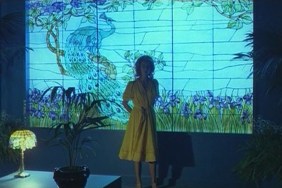
I have never stayed so long anywhere, says Delphine Seyrigs A in Alain Resnaiss enigmatic 1961 film Last Year at Marienbad. She cant recall meeting Giorgio Albertazzis X at the same château the previous year, but her words capture the films disorienting sense of time and place. Xs pursuit of A is a reminder that the past often haunts us. Luigi Bazzonis 1975 giallo Le orme, known in the U.S. as Footprints on the Moon, enraptures viewers with a similar time and memory spiral. The Italian title Le orme translates simply to “Footprints,” a much subtler reference to the films spellbinding visual impressions of one womans mysterious past.
At times, Bazzonis film seems unclassifiable, but still fits the structure and tone of a giallo with its focus on identity and mystery. Footprints is perhaps the only giallo to incorporate a science-fiction narrative so fully. If that isn’t unusual enough, especially for a film made during an era of Italian cinema fixated on black-gloved killers, there’s hardly any violence in Footprints. Florinda Bolkans Alice (a reference to the Lewis Carroll character who slips down the rabbit hole?) is tormented by visions of an exotic island, an opulent hotel, and an eerie dream about an astronaut abandoned on the moon. She is drawn to the desolate seaside town of Garma, where the residents seem to know her as Nicole even though she has no recollection of her time there. As Alice chases the specter of her past, her fragile psyche begins to unravel, revealing the terrifying truth.
Like Bazzonis Franco Nero-starring film The Fifth Cord, the directors most popular entry in the genre, Footprints also takes place in a hybrid setting. The movie opens in a modern city apartment resided in by a modern woman (Bolkans Alice isnt your typical giallo leading lady with her cropped hair and reserved pants suits), which subverts our expectations of the oft-set urban thriller. This enhances the films paranoia as we are whisked away to the island where Alice is an outsider a stranger, even to herself. In this case, the giallo genres typical convoluted plot that prizes style over story is an asset, contributing to the sense of unease.
What makes Footprints different from its brethren is the cosmic subplot, introduced as a fragmented memory of a film Alice once watched called Footprints on the Moon. This is represented as an otherworldly excerpt of a space traveler fighting for survival on the lunar body, flashbacks to a conference in which a speaker discusses the death of all biological life in the years 1990 and 2000, and a transmission featuring Euro cult star Klaus Kinski as a scientist named Dr. Blackman.
Allegorical science-fiction cinema that reflected the anxiety of a paranoid public exploded in the 1950s. But in the 70s, filmmakers explored the consequences of mans meddling with the unknown and the sacrifices made for the utopian promise of space. For Bazzoni, we Alice pay the price for this hubris with our own sanity, our humanity. The ghostly Garma reflects this societal collapse, where the islands visitors are often captured sleeping a living death. Bazzoni calls Alices mental capacity into question almost immediately. Its all those tranquilizers you take, says Alices friend after listening to the details of her strange celestial vision. Later, Alice discovers a yellow dress in her wardrobe a lurid symbol of her slipping sanity. Oscar-winning composer Nicola Piovani (Life Is Beautiful) and cinematographer Vittorio Storaro (Last Tango in Paris and Apocalypse Now) capture Alices fall with haunting effect. Where she lands is a nightmare.
—
Alison Nastasi is a giallo addict and the weekend editor of Flavorwire. You can find her talking about exploitation cinema, VHS, occult oddities, Hammer horror, and other genre fare on Twitter.









